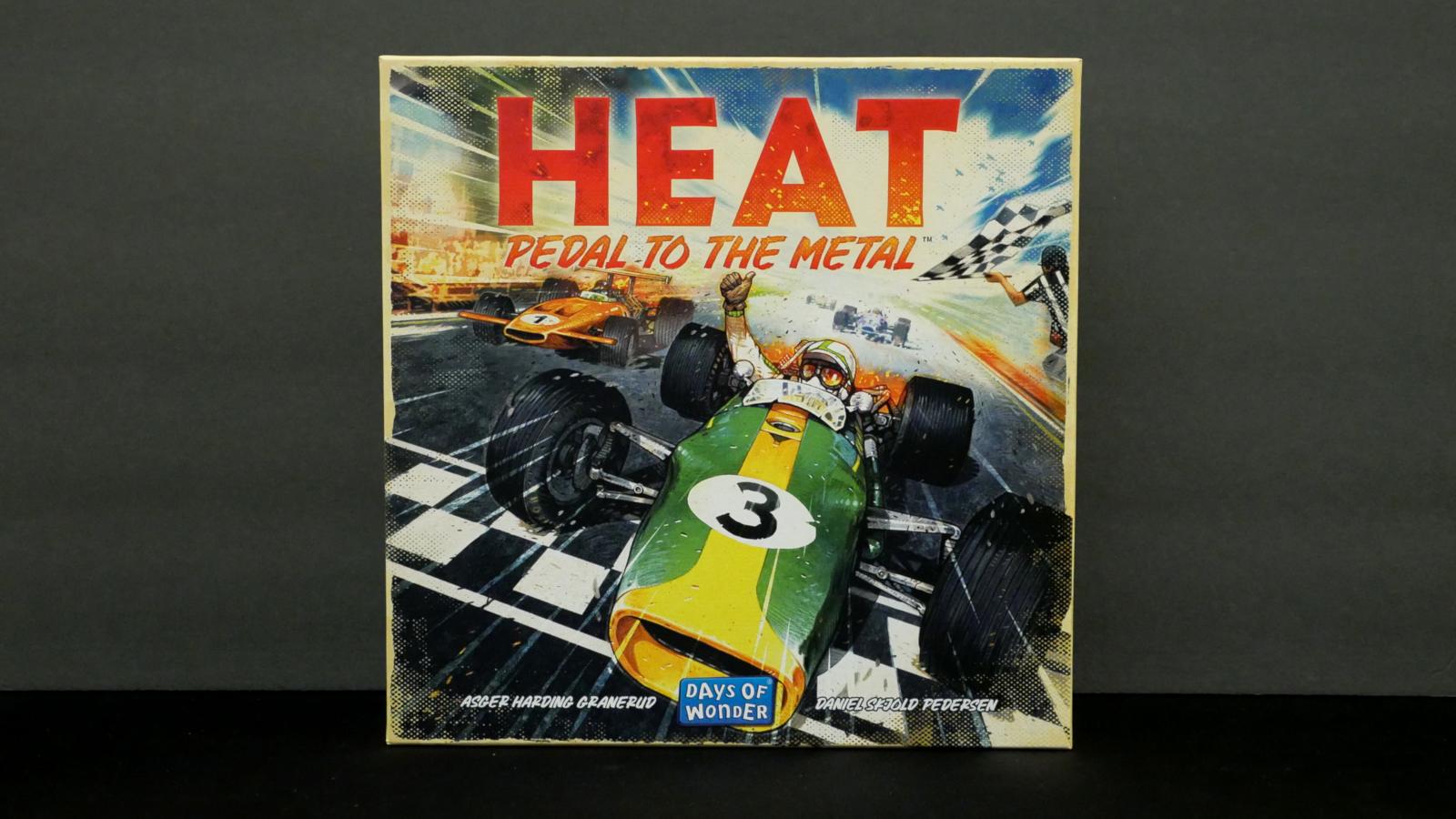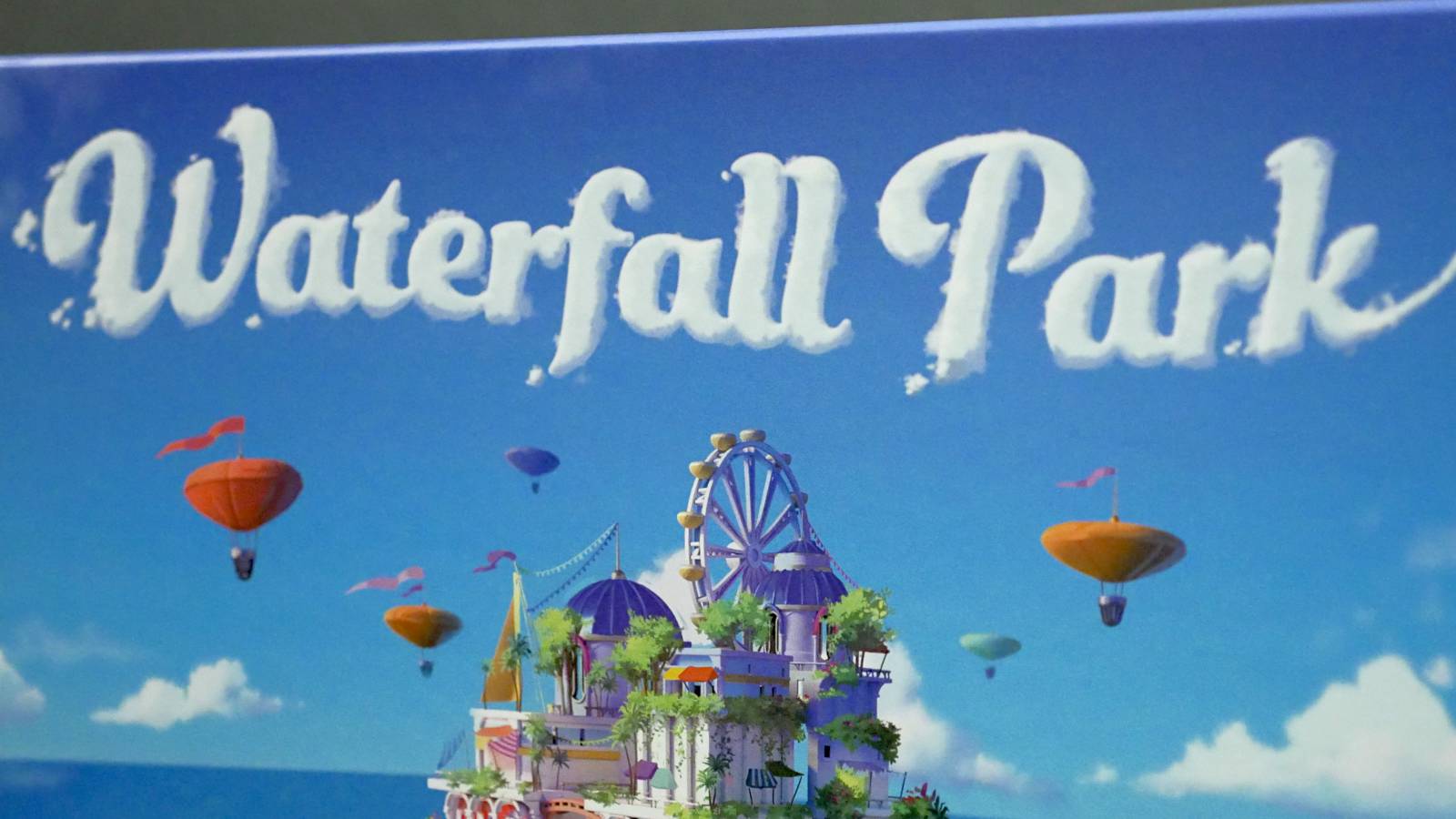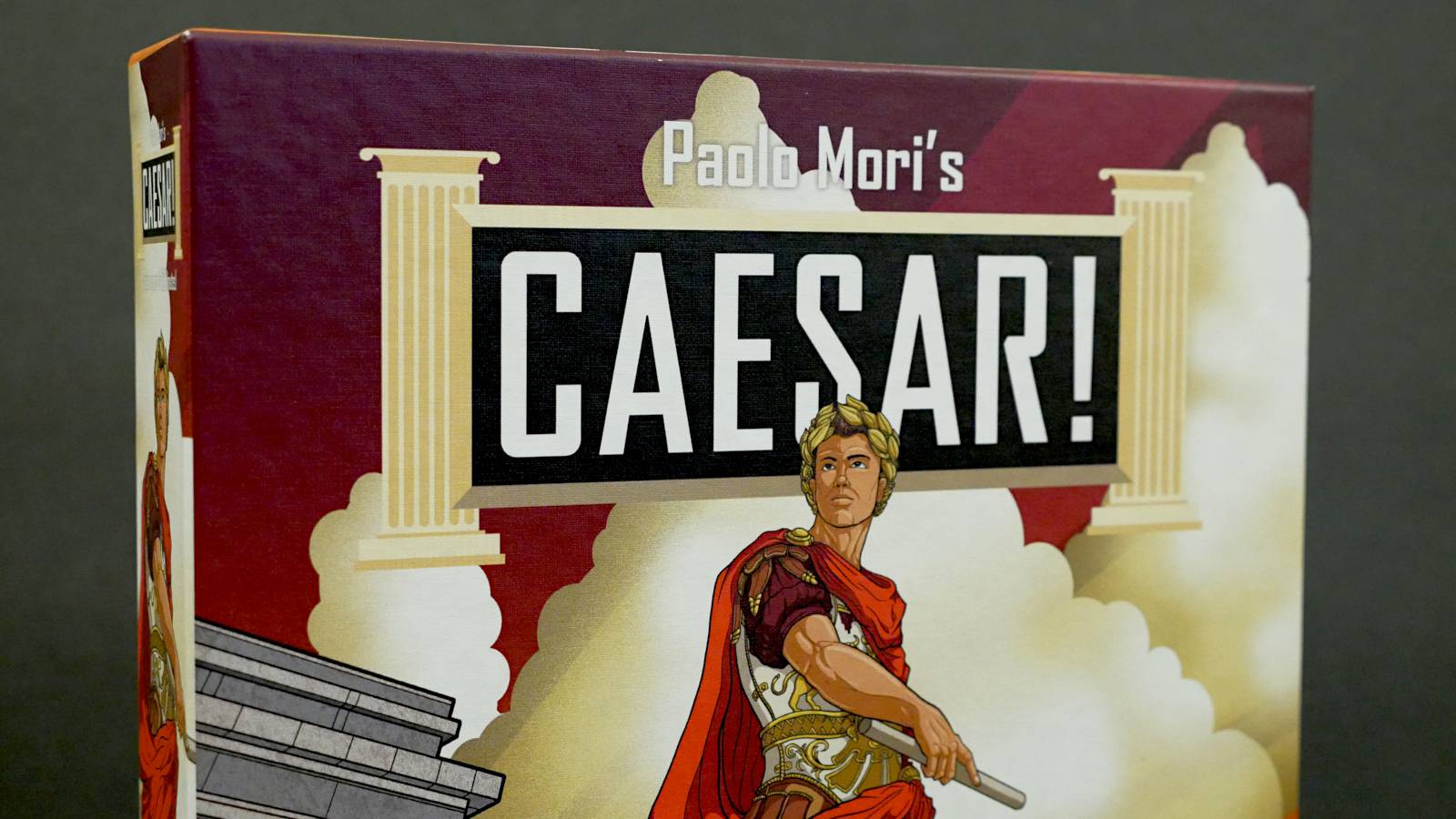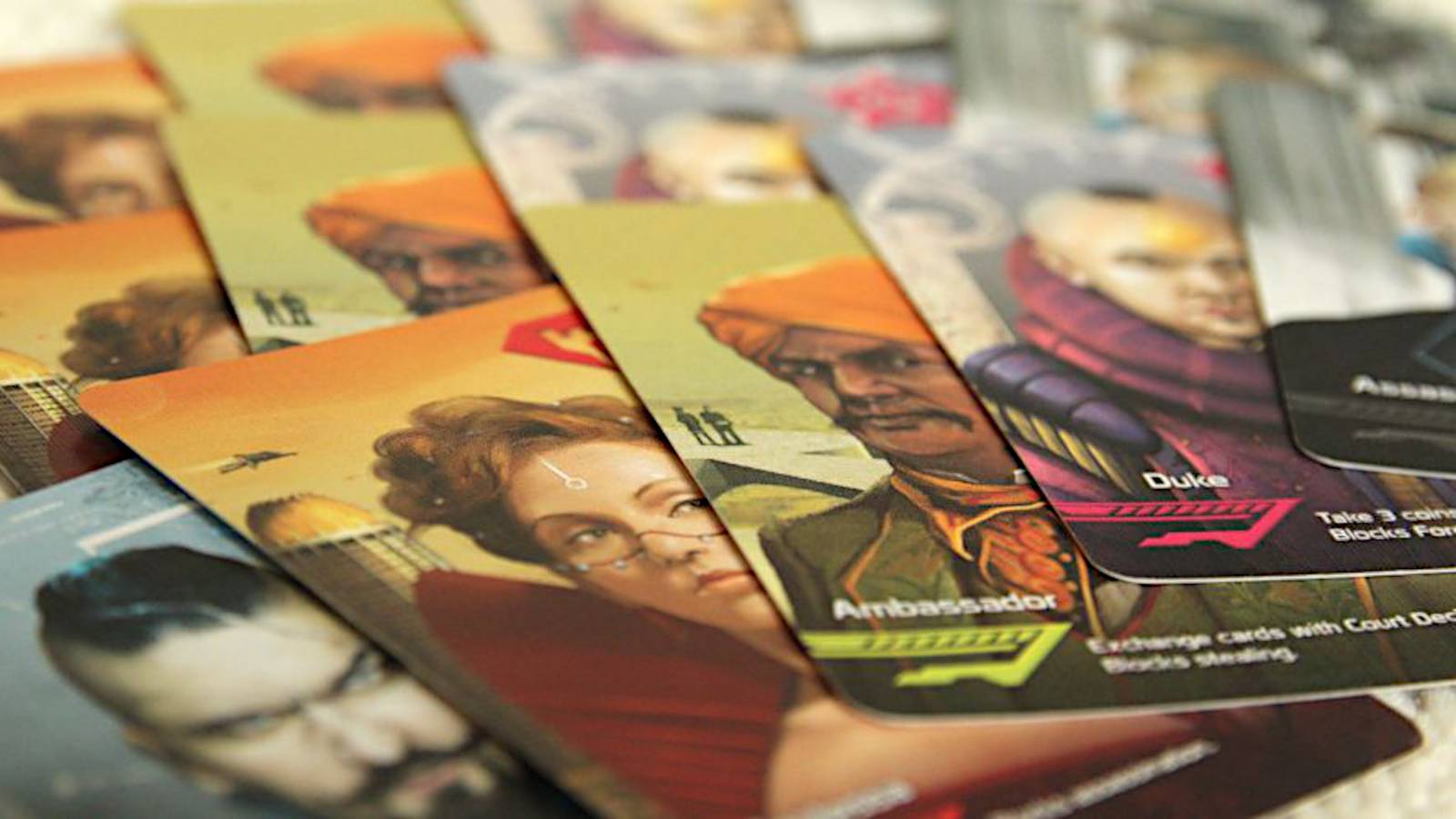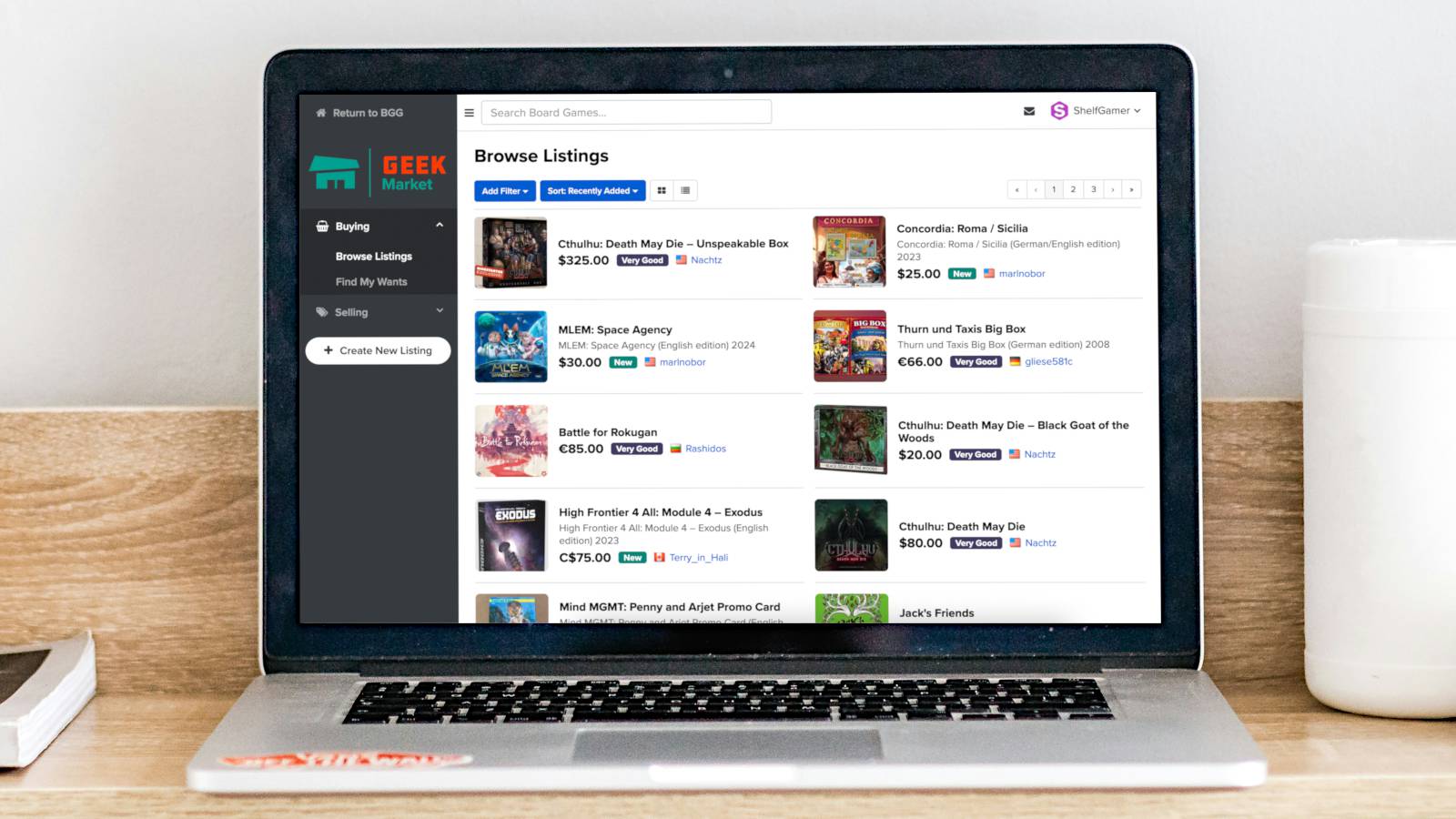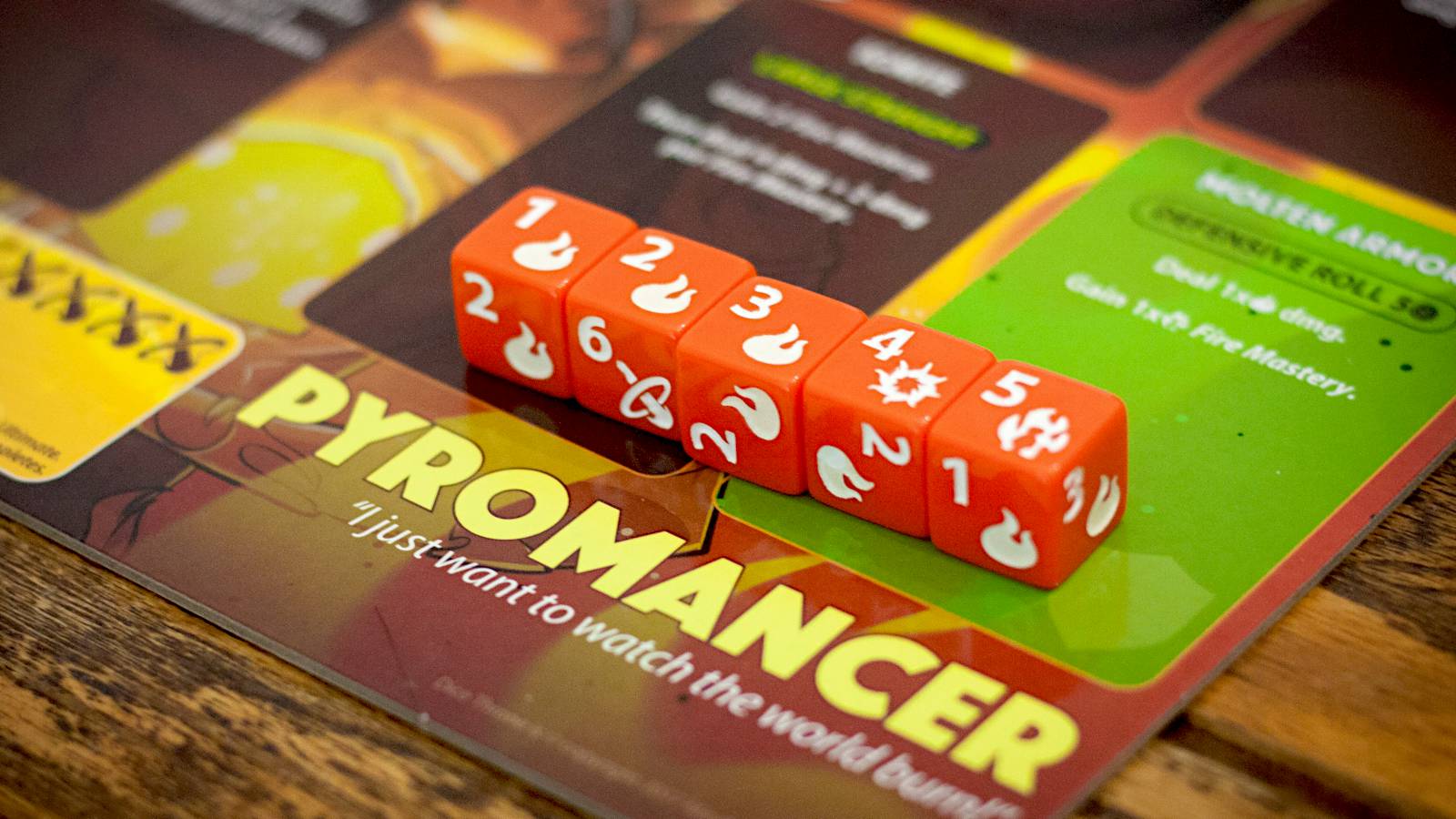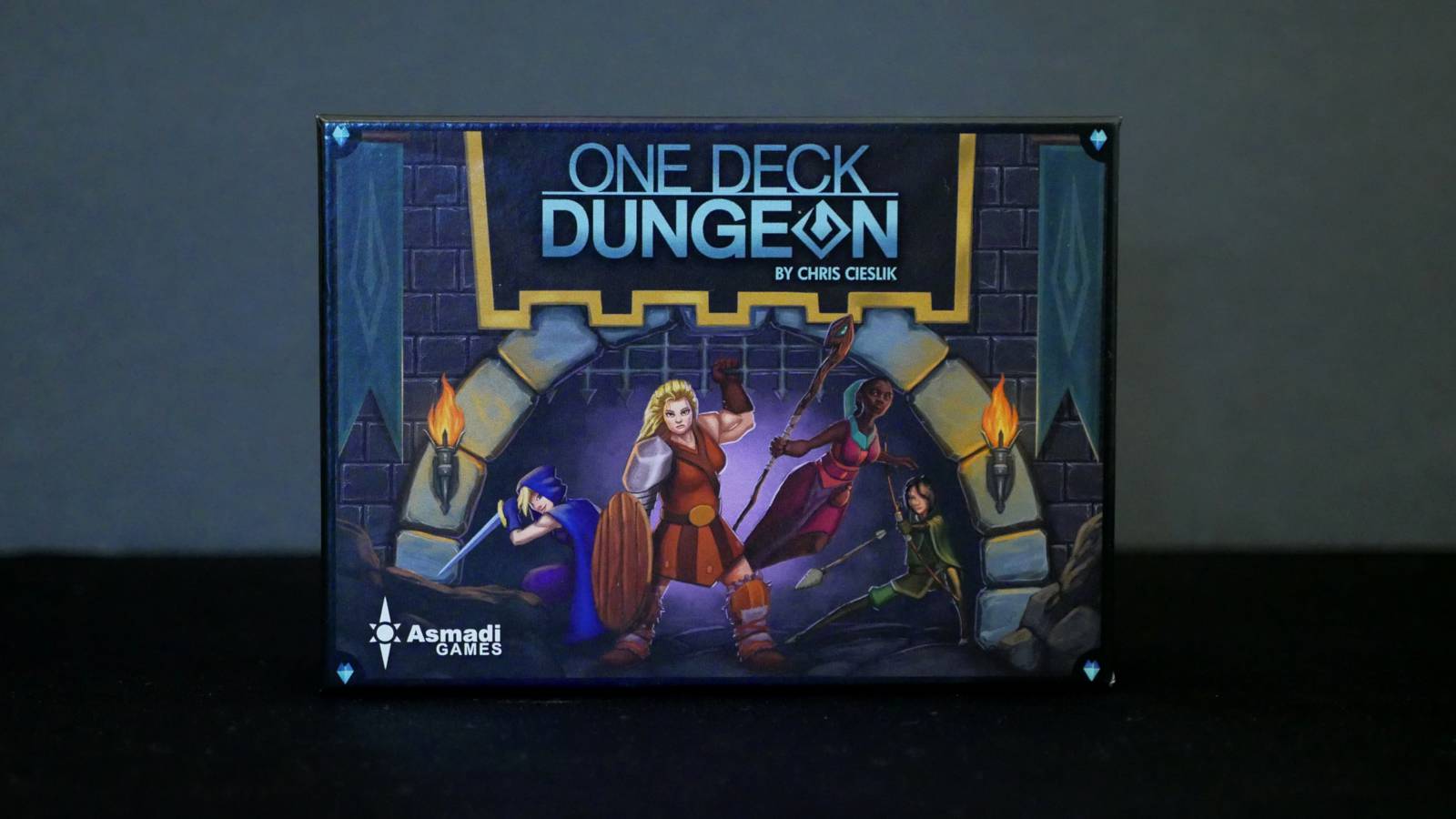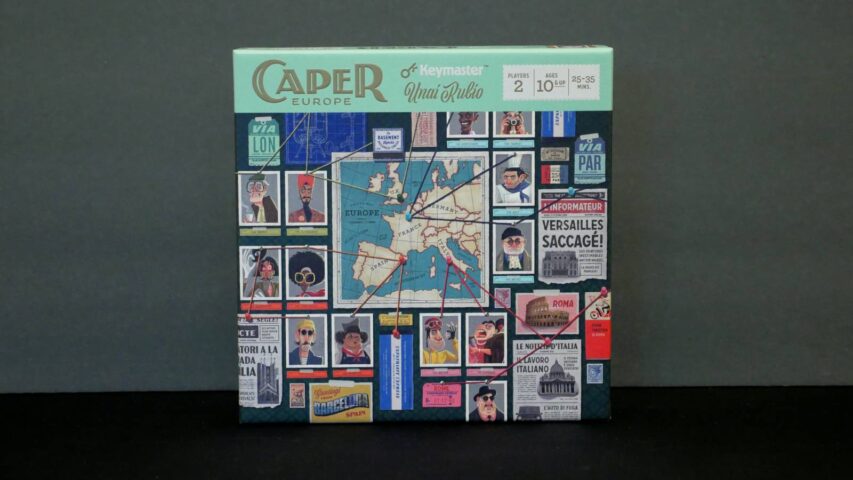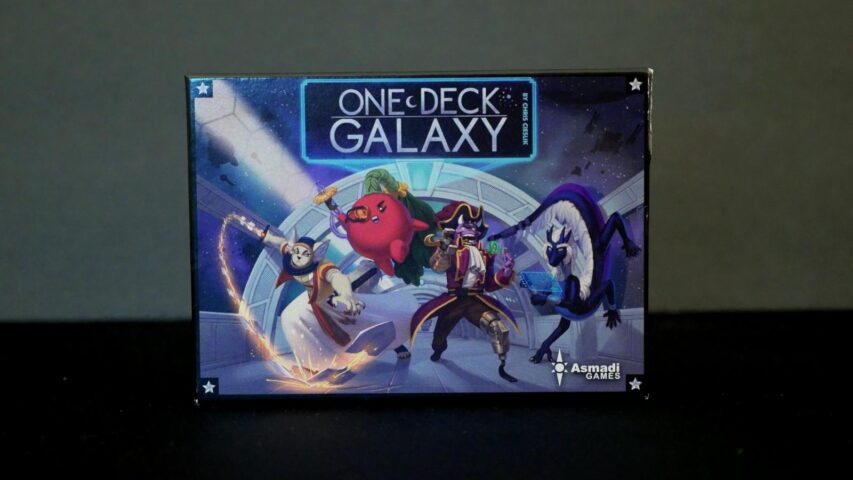Game: One Deck Dungeon
Release Year: 2016
Publisher: Asmadi Games
Designer: Chris Cieslik
Player Count: 1 to 2 players
Play Time: About 30 to 45 minutes
Rules Complexity: Moderate
Before solo board gaming exploded in popularity in 2020, it was seen as more of a niche genre amongst board gamers. Even now, despite all the reasons why solo board gaming is so great, people turn their noses up at the idea.
Which is why One Deck Dungeon deserves some recognition. It set itself apart as one of the better solo board game options at a time when people weren't really looking for this kind of game. In fact, One Deck Dungeon helped popularize the idea by blazing trails that led to wider appreciation for alone play.
But almost a decade after it first released, the shine of One Deck Dungeon has somewhat dulled and the rough edges are starting to show.
Here's everything you need to know about One Deck Dungeon, my experiences with it, and whether it's still a solo game worth having in your collection.
This review is based on a review copy of One Deck Dungeon provided by Asmadi Games. I played the game 10 times before penning this review and my thoughts and opinions are solely my own.
Overview

One Deck Dungeon is a card-based dungeon crawl simulator, where you play as one of five Heroes adventuring down through a Dungeon to face numerous Encounters and acquire Items and Skills along the way. A Boss awaits at the end of each Dungeon, if you can survive well enough to reach it!
I call it a simulator because you aren't actually doing much more than rolling dice and assigning them to various Encounter cards. The Items and Skills you acquire provide you with more dice and ways to manipulate your dice rolls.
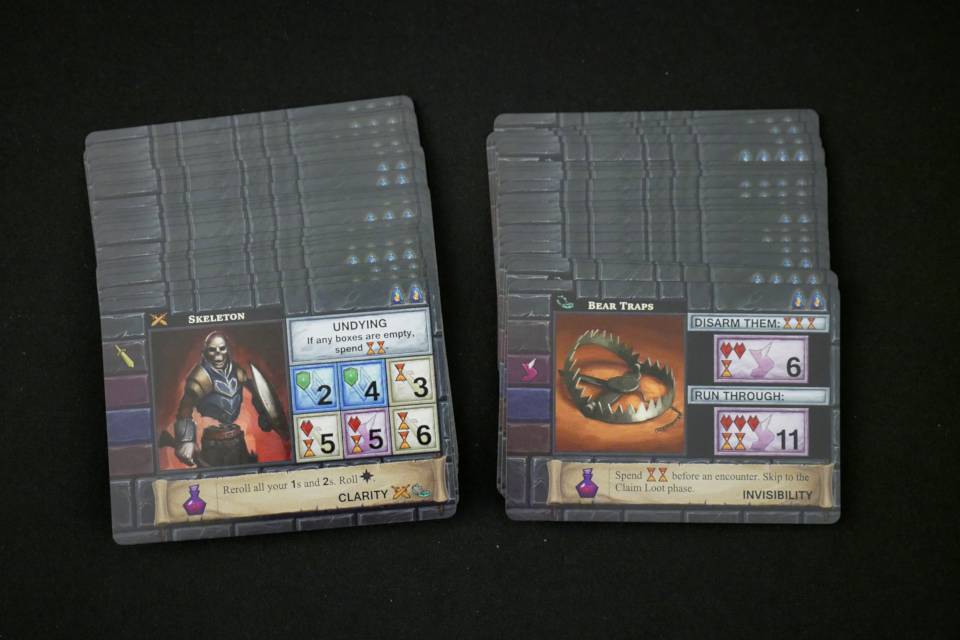
The Dungeon itself is represented as a deck of Encounter cards, and Encounters come in two types: Combat Encounters (i.e., creatures) and Peril Encounters (i.e., events and obstacles). They essentially work the same way, but certain Skills can only be used in certain Encounter types, thus limiting your options sometimes.
To progress through the Dungeon, you use the Explore action to draw four Encounter cards in a 2x2 grid. Then, you can choose to reveal them one by one, working through them (or not) and resolving them to acquire Loot.
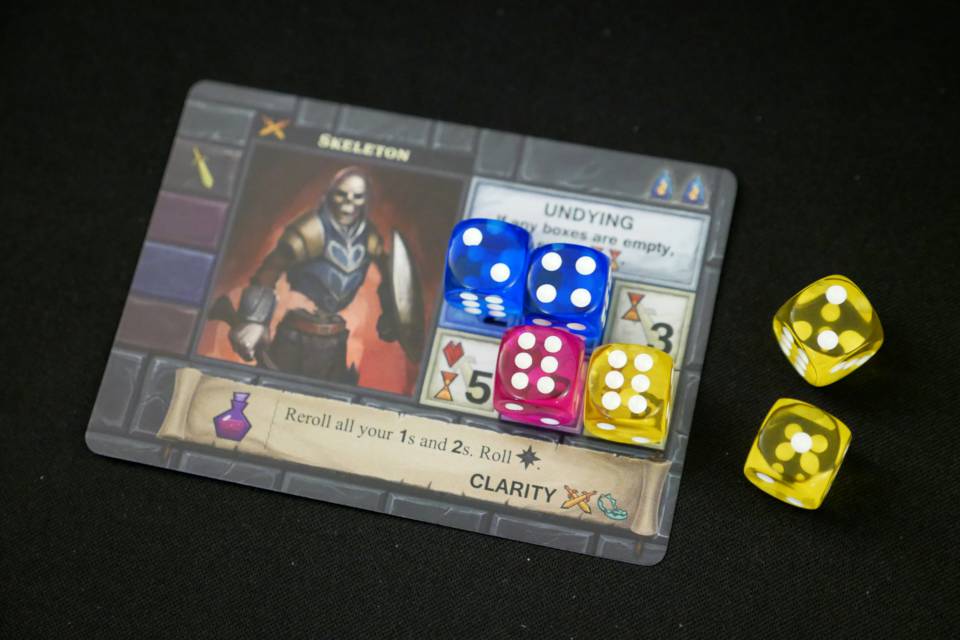
At the start of every Encounter, you roll dice. The dice come in three types, and the amount of each type rolled is determined by your Hero card and any Items you've acquired. Then, you assign the dice to the Encounter, attempting to cover every challenge box on the Encounter card. Any incomplete boxes on the Encounter card will incur penalties, but you can always claim an Encounter as Loot.
When claiming an Encounter as Loot, you tuck the Encounter card under your Hero card. (Simply change the orientation of the card when tucking to claim it as either Item or Skill.) Alternatively, you can tuck the Encounter card as XP. Gain enough XP and you'll level up, increasing how many Items and Skills you can have.
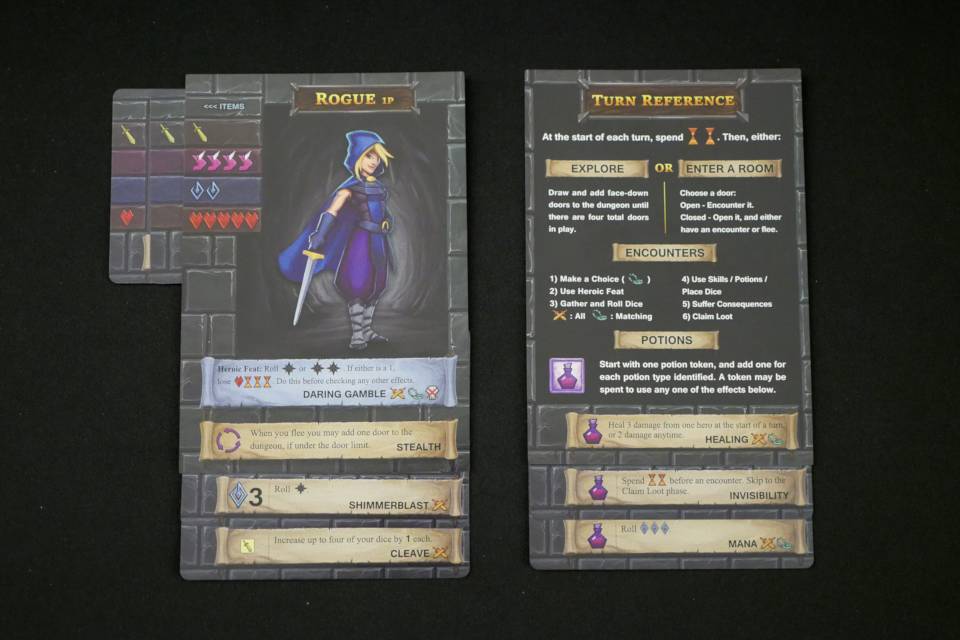
One Deck Dungeon also has the concept of Time. Various actions and penalties will cost Time, which means losing cards from the top of the Encounter deck. In other words, Time burns through the Encounter deck and shortens the number of Encounters you can have before reaching the Boss.
The Boss is essentially one big final Encounter with challenge boxes that are beefed up and tougher to resolve. Kill the Boss to win! Or die to lose.
This section is just an overview of the game's flow and basic concepts. There are a few other concepts in One Deck Dungeon that I haven't mentioned, like Potions and Heroic Dice. I'll explain those below in relevant sections where necessary.
Setup and Table Footprint
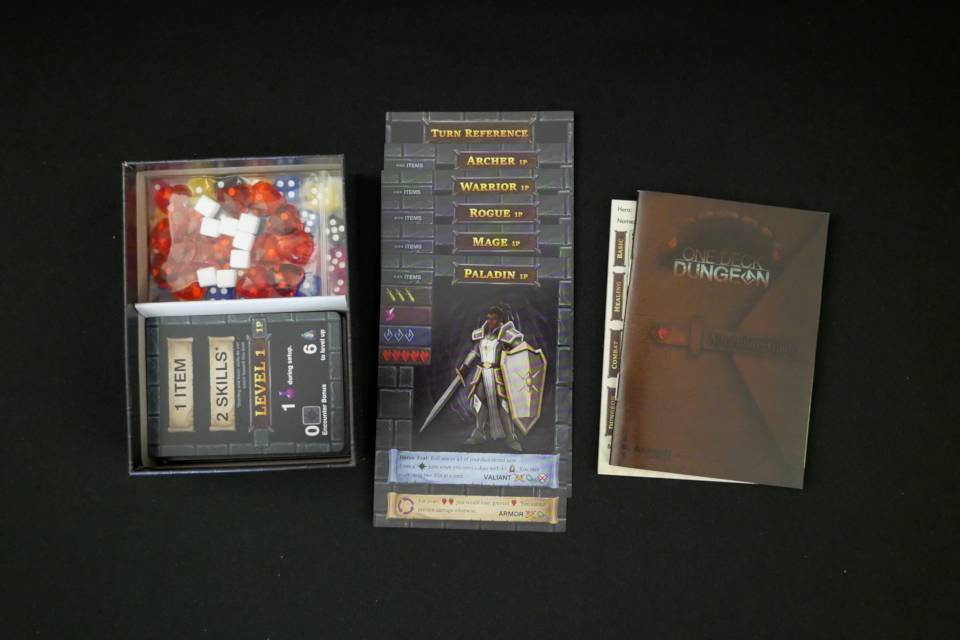
I really appreciate when a solo board game is quick to set up and doesn't need too much room to play, which is true of One Deck Dungeon.
Setting up isn't exactly straightforward the first time, but afterwards it's pretty smooth once you know what you need to do:
- Shuffle the Encounter deck and put the Stairs card on the bottom.
- Pick a Hero card.
- Pick a Dungeon card.
- Stack the Level cards in order.
- Put the dice and tokens to the side, ready to use.
All in all, I can be ready to play in 3 to 5 minutes. It really helps if you clean up properly, making sure all the cards are in their proper order when you pack them away. Setting up a breeze with a bit of care and preparation.
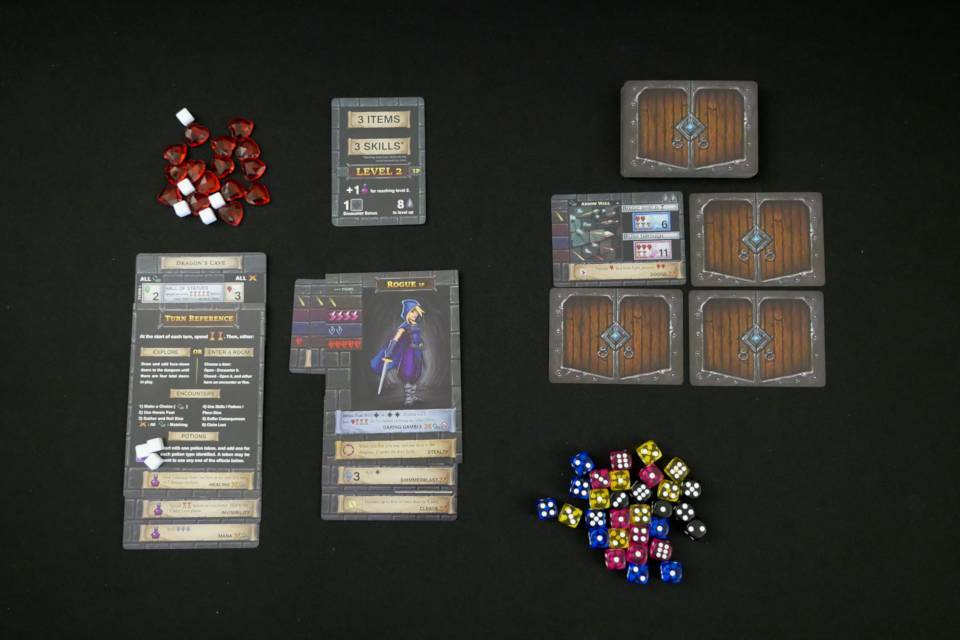
As for table space, One Deck Dungeon isn't the smallest game. You wouldn't be able to play on an airplane—it's rather fiddly with all the tucking of cards and rolling of dice—but you can easily play on a coffee table.
You just need enough room for: the Encounter deck plus four active Encounters, the Dungeon card and Potion tracker, your Hero card plus whatever Items and Skills end up getting tucked under it, plus the supply of dice and tokens.
Learning Curve
While One Deck Dungeon is relatively straightforward, it has several different elements that make for a somewhat clunky learn. Even though it comes with a player aid for turn sequence, you'll likely refer to the rulebook many times. It took me at least two games to adequately internalize the whole thing.
Indeed, the most difficult part of learning One Deck Dungeon is the turn sequence itself. You have to understand the order of the different phases if you want to make the right action decisions, so that's the biggest hurdle.
After that, you'll have to wrestle with some of the nuances in the phases—little asides and minor rules that are easily overlooked (e.g., when to pass time, how to place dice, the way certain skills only apply to certain types of Encounters, etc.).
This mental overhead—constantly checking and double-checking for this or that—made my first few plays of One Deck Dungeon tiring. However, once the order becomes second nature after several plays, it's pretty smooth.
Game Experience
Decision Space
Despite the simplicity and straightforwardness of One Deck Dungeon's design, you actually have several decisions to make every turn. Some are more important than others, of course, but they all add up and influence your chance of success.
Which Encounters are you going to tackle? When you first slip over an Encounter card, you can choose whether to tackle it right away or temporarily "flee" and return to tackle it later. The cost for doing this is 2 Time.
Some Encounters are more difficult than others, so you might need to acquire some Items and Skills before you can comfortably tackle one. But are you okay with the Time cost? More importantly, are you okay with leaving an Encounter card there to clog up your 2x2 grid of Encounter cards?
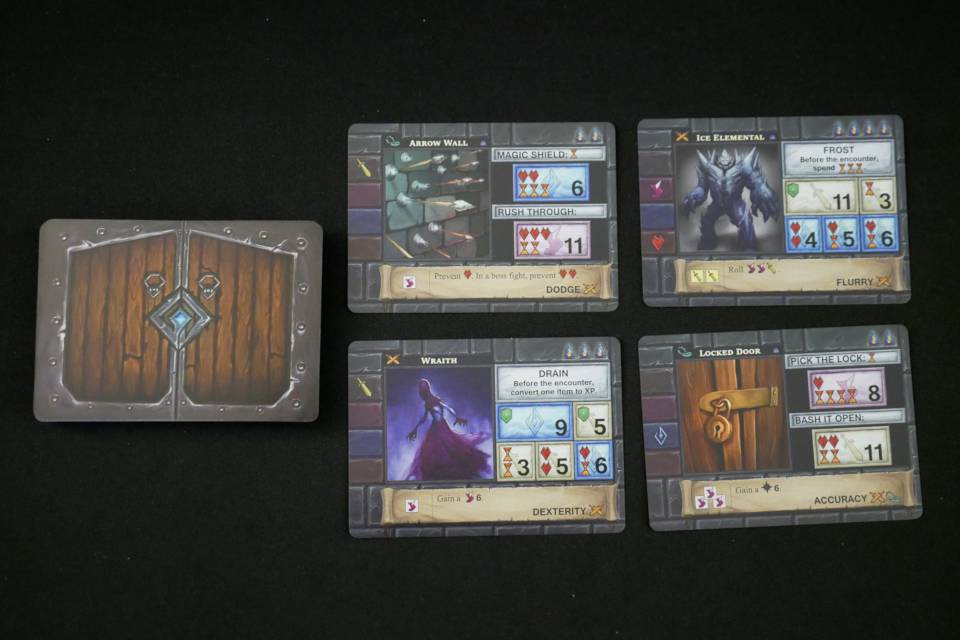
It's a small decision, but one that can have real ramifications. Maybe it's better to eat the bullet now even if you know you're going to take some damage and/or lose Time from incomplete challenge boxes, especially if the Encounter offers really good Loot (e.g., its Skill, Potion, Item, or XP).
How are you going to assign your dice? This is the main puzzle of One Deck Dungeon. You roll all the dice available to your Hero plus any extra dice provided by acquired Items, then assign them to the current Encounter. Hopefully you'll be able to cover all challenge boxes, else you'll take damage and/or lose Time.
When assigning dice, you have a special action available: you can combine any two dice to create a black Heroic Die, which is basically a wild die that can be used to fulfill any challenge box. When you combine dice, the resulting Heroic Die has a value equal to the lower value of the two combined die.

Most of the time, you're just combining leftover, unused dice that couldn't fulfill any of the challenge boxes and hoping you can make a Heroic Die that fits. Rarely, you might decide to sacrifice high-value dice in certain colors to fill a challenge box of a different color (perhaps because the cost of incompletion for that challenge box is worse than the other challenge box). But, again, it's rare.
In this regard, I think One Deck Dungeon offers the illusion of choice more than actual choice. More on this below under the "Luck Factor" section.
Are you going to use Skills? Skills grant various ways to manipulate your rolled dice. You might be able to change one type of die into another type of die, or re-roll certain dice, or flat-out change a value to some other value, or gain more dice of various types to add to your pool of rolled dice.

Skills are the primary method of luck mitigation, but most Skills require you to spend certain dice to gain and/or manipulate other dice. You'll have to decide which dice to spend, when to activate Skills, and in what order to activate Skills.
Each Skill can only be used once per Encounter, and certain Skills can only be used in certain types of Encounters (i.e., Combat and/or Peril).
Are you going to use Potions? Potions are very similar to Skills, except they're a lot more powerful and offer benefits that go beyond just dice manipulation. For example, one Potion lets you completely skip an Encounter and immediately turn it into Loot. Another Potion lets you turn two dice to values of 6 each.

Here's the catch with Potions: you have a limited number of Potion cubes, and you have to spend one cube every time you use a Potion. (You gain +1 Potion cube every time you loot a Potion and every time you level up. A cube can be spent with any Potion you have, not just the one it was looted with.)
Because of this limited resource, you have to really think about when to use Potions to maximize their impact. A wasted Potion can be crushing.
Are you going to loot as Item, Skill, Potion, or XP? When you resolve an Encounter, you have to face a tough choice. Every Encounter can be turned into either an Item, a Skill, a Potion, or XP. The more difficult the Encounter, the more valuable each of these options are for that Encounter as Loot.
These are the most impactful decisions you can make in One Deck Dungeon. Items provide you with more dice for future Encounters while Skills and Potions provide you with more versatility in dealing with rolled dice. XP lets you level up so you can have more Items and Skills, which also helps you prepare for future Encounters.
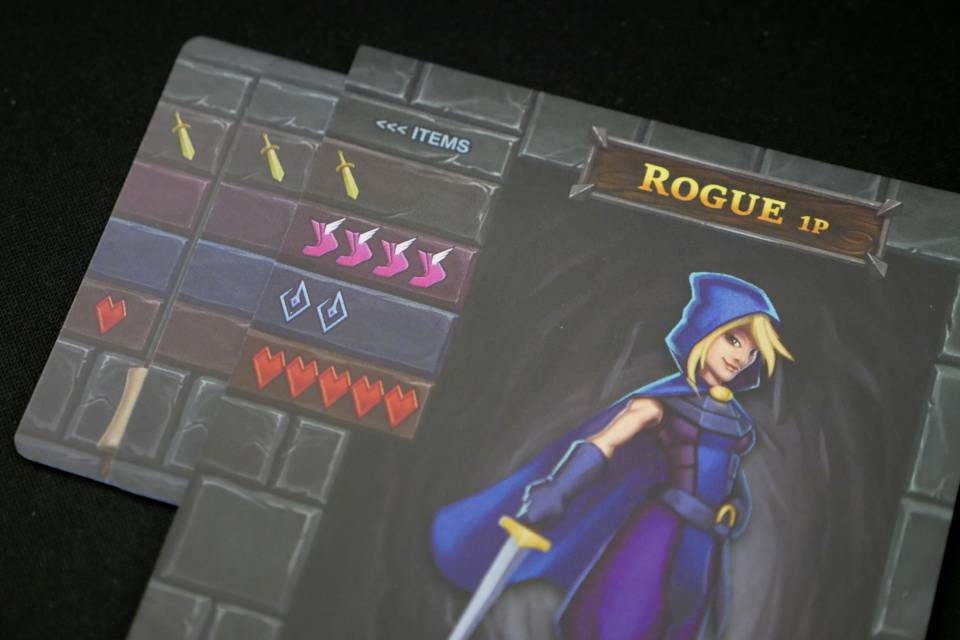
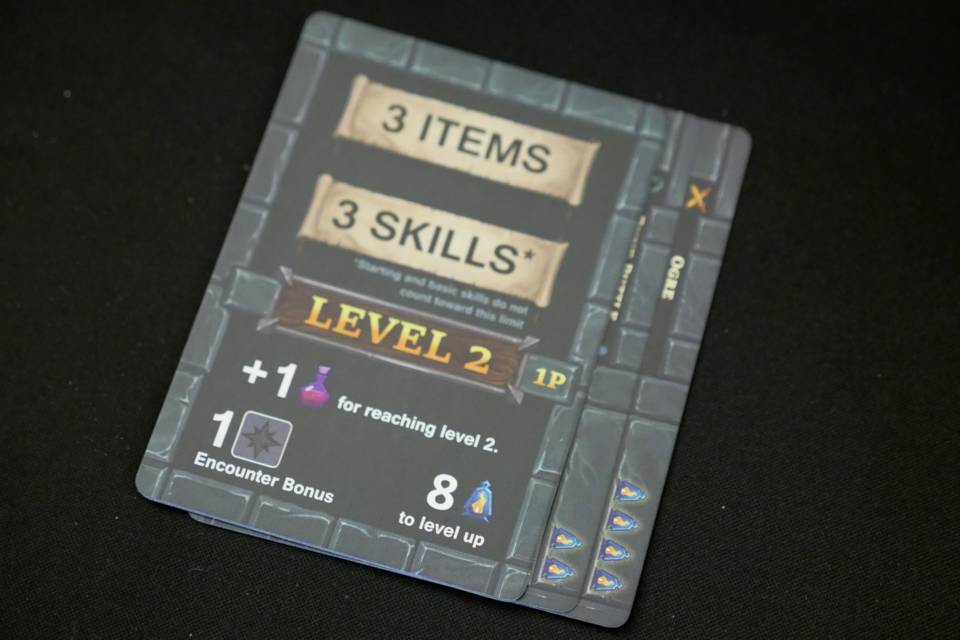
There's a bit of strategizing here, as you'll want to synergize your Items and Skills with your Hero to ensure a healthy balance of accessible dice types and widened capabilities for what you can do with the dice you roll. A smart mixture of Skills and Items is necessary to succeed, especially in the tougher Dungeons.
Luck Factor
In any given playthrough of One Deck Dungeon, your chance of success is heavily based on luck. There's just no way around that. While the game provides some degree of luck mitigation, there isn't enough of it to offset the fact that you can be seriously boned and derailed by a single bad dice roll.
A single bad dice roll can be devastating. I still remember one Encounter where I rolled four Red dice, four Yellow dice, and four Blue dice only for all of the dice to come out as 1s, 2s, and 3s. Seriously, not a single 4, 5, or 6. I wasn't able to manipulate any dice yet, so I couldn't fulfill any challenge boxes. I took 8 damage and died.
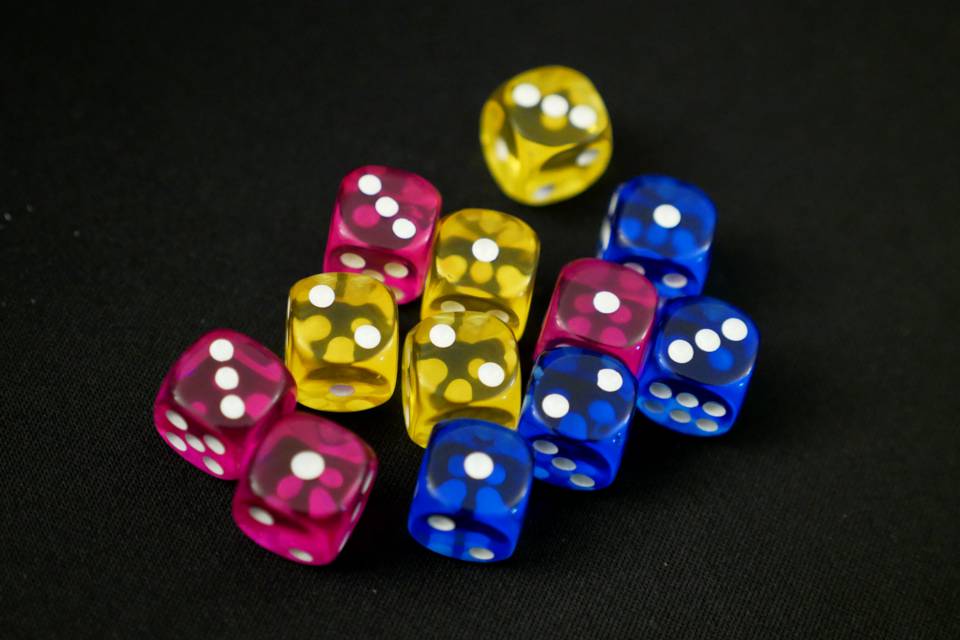
What's most frustrating about this is the realization that even if I had a few Skills to manipulate my dice, I'd still only be able to fulfill maybe one or two challenge boxes—and the remaining incomplete challenges would still wreck me.
At its core, One Deck Dungeon is a dice-rolling game and everything hinges on those dice rolls. If you have a bad roll, your dungeon run is going to be cut short. There isn't enough luck mitigation, even with Heroic Dice! Which brings me to my next point...
In practice, Heroic Dice aren't very useful. I love the idea that you can combine leftover, unused dice into wild dice that can be used for any challenge box. In theory, it's a smart way to deal with situational excess of different dice types. The problem is, the resulting Heroic Die takes the lower value of the two combined dice.
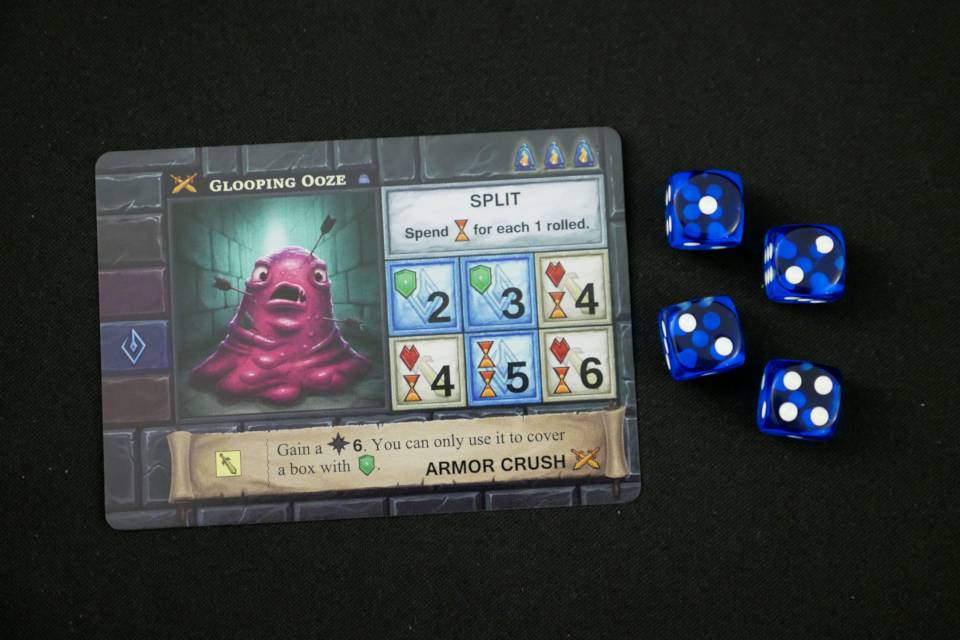
Imagine you need a Blue 5 for a certain challenge box. You roll four Blue dice and they come out as follows: 1, 2, 2, 4. Not only do you lack the necessary Blue 5, you also lack the opportunity to create a Heroic 5. At best, you can combine your Blue 4 with a Red 4 or Yellow 4 to create a Heroic 4... which doesn't help at all.
In other words, Heroic Dice are only useful when you have an excess of high-value dice, which means they're only useful when you have a super lucky dice roll. The concept of Heroic Dice appears to be meant as a way to mitigate unhelpful dice, but in practice, it's the opposite.
If you're open to house rules, you can inject some utility into Heroic Dice by allowing the combination of two Heroic Dice into one Heroic Die of summed value. (For example, a Heroic 1 plus Heroic 3 equals a Heroic 4.) However, this will likely throw off the balance of the game, so use with caution.
Fun Factor
The heavy reliance on luck is what kills the fun for me in One Deck Dungeon.
Normally, I really like dice-centric games because there's an inherent tension in random dice rolls. You hope for the best. You cheer when you come out ahead. You're gutted when the dice don't come out in your favor. You strategize to maximize your odds, and every dice toss is a thrilling moment.
Not so in One Deck Dungeon, and I think it's because you aren't actually rolling for a certain result. It's not like you're aiming to roll a 16 so you can "win" a difficulty check. Instead, you're rolling a big handful of dice and just seeing how things fall.
There's no purpose in the dice roll, which robs the roll of its thrills. It's more akin to opening a box of random jigsaw pieces, then figuring out how those pieces fit together—and sometimes realizing that the pieces don't fit together.
Your odds of success come down to the sequence of boxes you open. The luckier you are, the more likely you'll reach the end. To me, that isn't fun.
Pacing
My favorite thing about One Deck Dungeon is the pacing.
The Encounter deck consists of 44 cards. You have to go through the Encounter deck three times to reach the Boss of the Dungeon, with each time through the Encounter deck representing one "floor" of the Dungeon.
The thing is, every time you resolve an Encounter, it gets taken out of the Encounter deck (because you loot it as an Item, Skill, Potion, or XP). This means every resolved Encounter shortens the time through the next floor.
Combine this with the Time mechanism—where various actions and penalties burn through cards from the Encounter deck—and you experience a sort of acceleration as you progress through the Dungeon.
Each floor is faster than the last, which is great because each floor is tougher than the last. There's a steady increase in difficulty, but it ramps up without overwhelming. And if you do reach the Boss, it really feels like a final showdown where everything is on the line. Win or lose, this is it! I like that.
Fiddliness
One of the biggest reasons why One Deck Dungeon isn't my go-to solo board game—other than the aforementioned "Luck Factor" issues—is that it's too fiddly for my liking. There are three main sources of fiddliness here.
Too much card flipping. This is the smallest complaint of the three, but I'm not too keen on the execution of the Time mechanism where you have to constantly flip and burn cards from the Encounter deck. I really like card games, but the amount of flipping in One Deck Dungeon gets repetitive fast.
Too much dice movement. It's not that I don't like dice placement games—Fantastic Factories is a great example—but it feels excessive in One Deck Dungeon. You have to juggle 10+ dice every Encounter, constantly returning them to the supply, retrieving new dice, exchanging dice for other types of dice.
The same goes for Heart tokens and Potion cubes, although to a lesser degree. Damage and healing are core mechanisms, so you're likely moving at least one Heart token after every Encounter. Potions are rarely used, but it's still yet another token.
Too much card tucking and untucking. To me, this is the most irritating aspect of One Deck Dungeon. Despite playing on a neoprene surface, the act of tucking cards is quite a nuisance for me. It doesn't always slip under easily, especially when you've already tucked several cards.
And it wouldn't be so bad if you only had to tuck them—but you also have to untuck certain cards at certain times, which is a huge pain in the neck. If you don't want to make a mess, you basically have to take them all out, remove the unwanted card, and then tuck them all back under. Ugh, I don't approve!
Replayability
Technically, while no two games of One Deck Dungeon are ever the same because the Encounter deck is always shuffled, the game very much feels the same every time.
Even if Encounters come in two flavors (Combat and Peril), they're all resolved the exact same way: roll dice, manipulate dice, and place dice. The differences between Encounters don't change anything as far as the core gameplay or the decisions you make, so it's the same thing Encounter after Encounter with slight tweaks.

Now, that might not be a bad thing if you like the design of Encounters and their challenge boxes. However, I personally don't like it due to the heavy luck factor that saps most of the tension and deflates what could've otherwise been an engaging puzzle-style gameplay.
Doesn't One Deck Dungeon have a lot of variability in setup? Sure. You can choose between five Hero cards, which change the makeup of your starting dice, your unique Heroic Feat, and your starting Skill. You can also choose between five Dungeons, which slightly alter the flavor of Encounters.
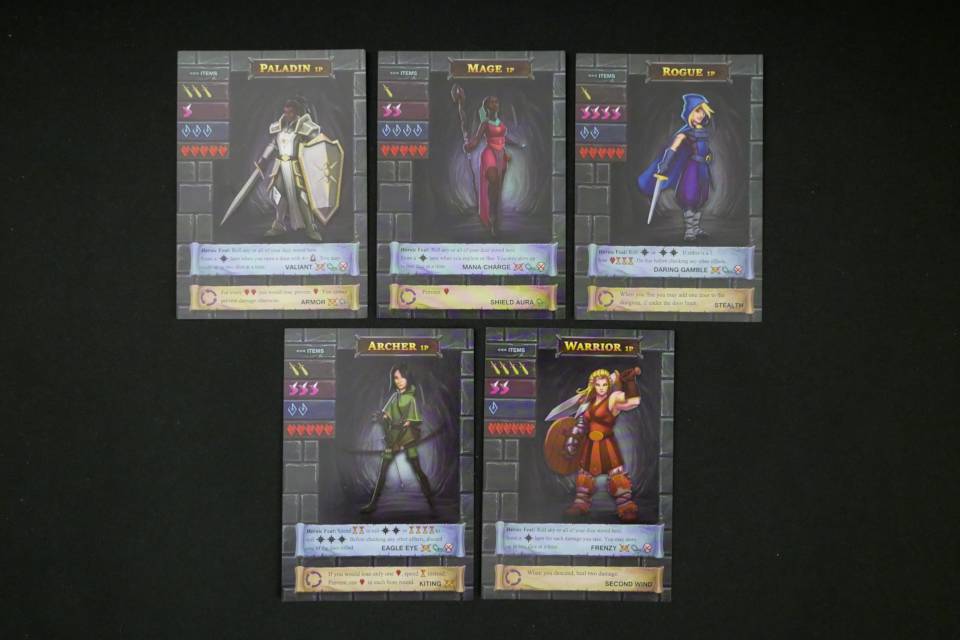
It's no different here: the variable setups don't actually change anything of substance. They're surface-level tweaks that feel inconsequential.
However, the built-in Campaign Mode does serve replayability a lot! One Deck Dungeon comes with a pad of Campaign Sheets, with one sheet representing one single campaign spanning up to 20 games. The goal in a campaign is to defeat all five Bosses in as few games as possible.
But there's more to the campaign! Because whenever you play a game, you earn checkmarks that can be spent to unlock various Talents, which are special abilities and benefits that you can use in future games in that campaign. (For example, the Fortitude Talent lets you re-roll all Yellow 1s and 2s in Combat.)

What's nice is that you can earn checkmarks even if you don't defeat the Boss in a game. In fact, you earn a checkmark every time your Hero levels up and every time you descend to the next floor in the Dungeon!
This is great because no game ever feels like a waste—even if you "lose," you still move forward in the campaign. Then, as you get stronger through unlocked Talents, you're more capable of tackling the harder Dungeons.
There's a real sense of progression through the campaign, and it adds a significant amount of interest to play over and over again as the same Hero.
Production Quality
Generally, small box solo games have impressed me with their production quality. One Deck Dungeon is not one of those games. Maybe my expectations were too high, but I was disappointed by the rather mediocre production here.

The cards feel cheap but serve their purpose. These cards are made of your average card stock with an unremarkable glossy finish, resulting in an experience that feels very much like an indie project. Not terrible, just purely functional.

The dice are small and translucent, which comes with problems. On the whole, I really dislike translucent dice. The faces on certain colored dice can be hard to read in certain types of lighting, which harms the experience. These dice are also small and rounded, making it easy to accidentally bump them to a different face value. (As careful as I am, it's happened to me numerous times.)
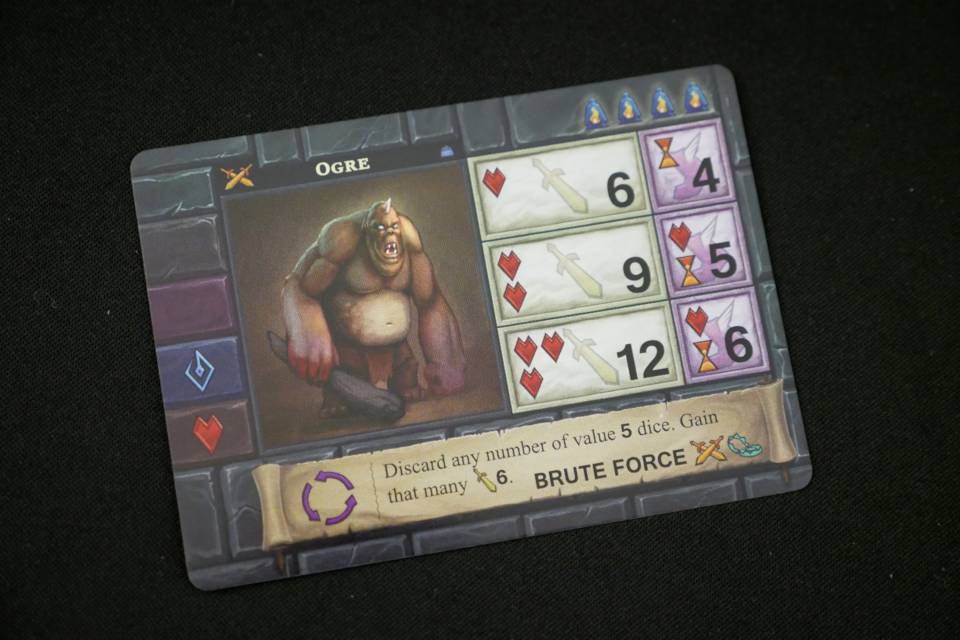
The graphic design is clear and intuitive. This point's very important because of how the cards tuck under the Hero card. Not only is every Encounter card designed in a way that makes sense—you'd likely get the gist even without knowing the rules—but they're perfectly readable with intuitive iconography.

The plastic hearts and cubes are nice. Did One Deck Dungeon need plastic hearts? Absolutely not. But they do add an interesting touch! The plastic Potion cubes are also unique, as most games would've made them wooden instead. Unfortunately, these two components are two of the least important in the game, so I'm puzzled as to why Asmadi Games put that much effort into them. Hmm...
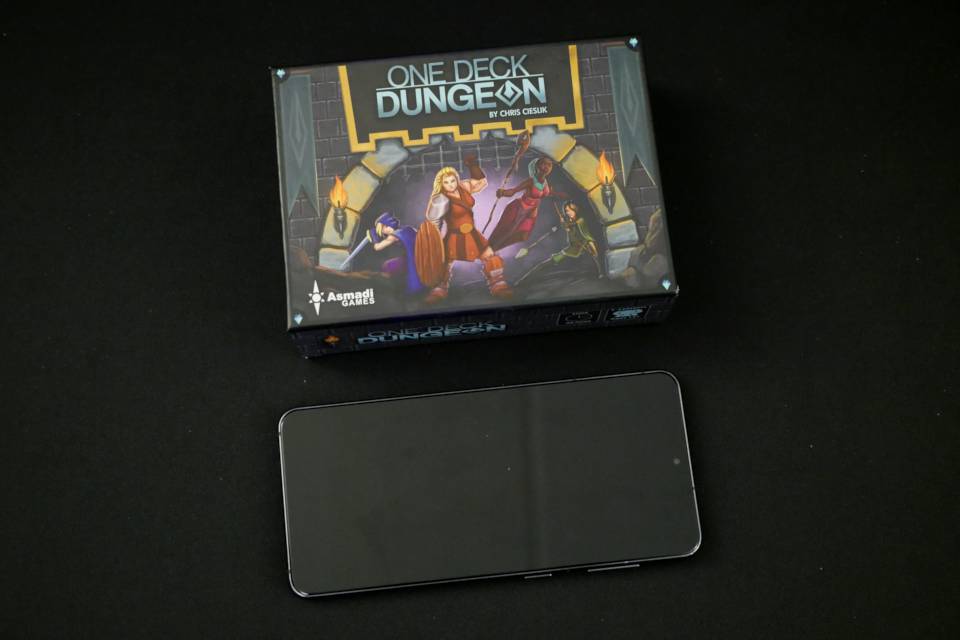
The box is small, compact, and without wasted space. One Deck Dungeon's box is perfectly portable, so it's a viable game to take with you if you're staying at a hotel, visiting someone's home, or even going camping. Not small enough to fit in a pocket, but small enough to toss into a backpack.
The Bottom Line
One Deck Dungeon
- Simulates crawling through a dungeon, fighting monsters, and looting rewards
- Variability through different Hero and Dungeon/Boss matchups
- Lots of small decisions that add up and influence success
- Campaign Mode injects a lot of replayability through permanent upgrades
- Success in an encounter comes down to the luck of the dice
- Not enough luck mitigation to overcome bad dice rolls
- Heroic Dice combo mechanism feels almost pointless
- Excessively fiddly with too much tucking and untucking of cards
- Mediocre production quality overall
Buy this game • Amazon • Game Nerdz • Noble Knight Games. If you buy using these links, I may earn a commission at no extra cost to you. It's one way to support me and this site. Thanks!


